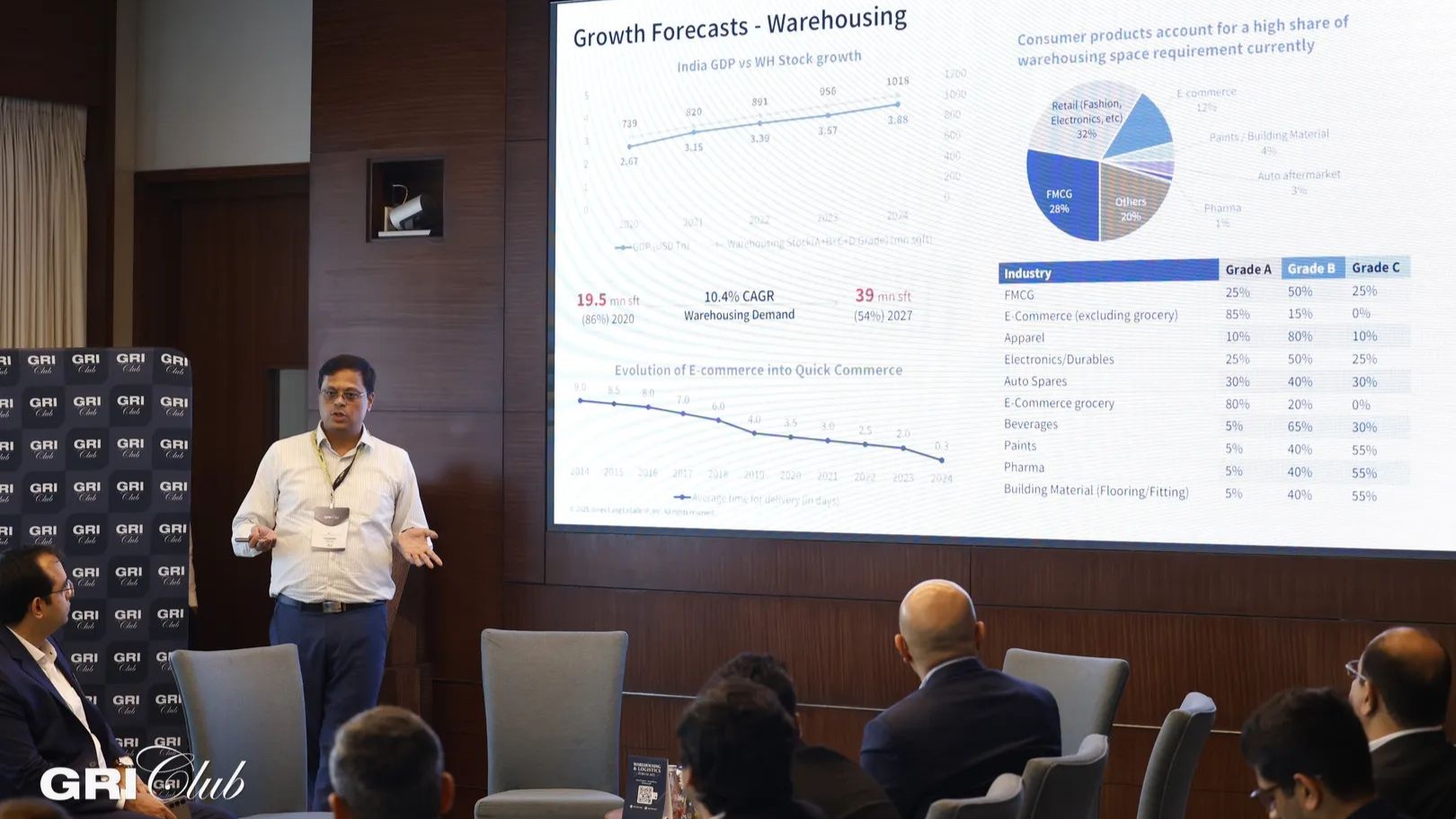 Credit: GRI Club
Credit: GRI ClubInsights from GRI Club India’s Warehousing & Logistics Forum 2025
Real estate industry leaders, developers, investors, and stakeholders discuss key trends and challenges in the Indian warehousing
June 6, 2025Real Estate
Written by Isabella Toledo
India's warehousing and logistics sector has experienced significant growth, particularly between 2021 and 2024, with committed capital nearly doubling from USD 4 billion to USD 8.9 billion. This surge highlights both the sector's post-pandemic recovery and the increasing recognition of India’s strategic importance within global supply chains.
A key turning point came in 2017 with the introduction of the Goods and Services Tax (GST), which centralised supply chain management and reduced logistics costs by addressing inefficiencies caused by state-level taxation.
This policy shift laid a strong foundation for rapid sector growth, driving both investment and infrastructure development in major cities such as Mumbai, Delhi, Bangalore, and Hyderabad, and firmly positioning India as a leading global warehousing hub.
Looking ahead, the rise of urban fulfilment models is gaining momentum as developers and logistics companies explore opportunities in more densely populated cities. This includes the emergence of micro-fulfilment centres, dark stores, and in-city warehouses designed to support fast delivery models and reduce last-mile logistics costs.
The rising demand for strategically located, large-scale facilities is largely driven by the need to integrate advanced technologies, including automated sorting systems, conveyors, and robotics. As automation becomes the norm, businesses are increasingly seeking spaces capable of accommodating these innovations, enhancing operational efficiency and driving down costs.

E-commerce continues to be one of the largest contributors to this demand, with companies needing increasingly larger and more sophisticated warehousing facilities to manage their expanding operations while supporting rapid inventory turnover and fulfillment cycles.
FMCG (Fast-Moving Consumer Goods) companies have also emerged as major occupiers. With the country’s growing consumption patterns, particularly among younger buyers, FMCG players require vast amounts of space for storing goods across various categories.
Similarly, sectors such as retail, pharmaceuticals, and consumer electronics have shown a consistent need for Grade-A spaces due to the nature of their products and the need for temperature-controlled environments, as well as compliance with stricter regulatory standards.
Another significant driver of demand is the ongoing shift in manufacturing strategies, particularly the "China Plus 1" approach of diversifying investments away from the Asian giant due to increasing costs and risk, which has resulted in the relocation of some manufacturing operations to India.
This trend is likely to increase the demand for warehousing spaces tied to manufacturing hubs, as the government’s push for manufacturing through initiatives such as the Production Linked Incentive (PLI) scheme has further stimulated demand, attracting investments from over 670 companies across 15 sectors.

This surge in land prices has created a dual challenge for the sector. On one hand, developers face higher upfront costs, which can erode profitability. On the other, these price increases make it increasingly difficult to acquire land for large-scale developments, particularly in areas once considered more affordable.
As a result, developers are now focusing on purchasing already-developed assets or exploring opportunities in regions with lower land costs. However, these alternatives come with their own set of challenges.
To mitigate these issues, developers are turning to secondary and tertiary markets, where land prices remain more competitive. Some are forming partnerships with local governments or other stakeholders to secure land at more favourable rates, while others are repurposing existing industrial spaces for warehousing.
The rising cost of land has also driven up demand for developed assets, as they are already built and ready for immediate use. Regional developers who have invested in high-quality facilities are seeing significant returns on their investments, as they are able to sell or lease properties at premium rates.
India's warehousing and logistics sector has experienced significant growth, particularly between 2021 and 2024, with committed capital nearly doubling from USD 4 billion to USD 8.9 billion. This surge highlights both the sector's post-pandemic recovery and the increasing recognition of India’s strategic importance within global supply chains.
A key turning point came in 2017 with the introduction of the Goods and Services Tax (GST), which centralised supply chain management and reduced logistics costs by addressing inefficiencies caused by state-level taxation.
This policy shift laid a strong foundation for rapid sector growth, driving both investment and infrastructure development in major cities such as Mumbai, Delhi, Bangalore, and Hyderabad, and firmly positioning India as a leading global warehousing hub.
Looking ahead, the rise of urban fulfilment models is gaining momentum as developers and logistics companies explore opportunities in more densely populated cities. This includes the emergence of micro-fulfilment centres, dark stores, and in-city warehouses designed to support fast delivery models and reduce last-mile logistics costs.
Shift Towards Grade-A Warehousing
By 2024, India had seen a substantial increase in the stock of institutional-grade warehousing, with around 238 million square feet of Grade-A space across the top eight cities surpassing lower-grade spaces in new developments.The rising demand for strategically located, large-scale facilities is largely driven by the need to integrate advanced technologies, including automated sorting systems, conveyors, and robotics. As automation becomes the norm, businesses are increasingly seeking spaces capable of accommodating these innovations, enhancing operational efficiency and driving down costs.

E-commerce continues to be one of the largest contributors to this demand, with companies needing increasingly larger and more sophisticated warehousing facilities to manage their expanding operations while supporting rapid inventory turnover and fulfillment cycles.
FMCG (Fast-Moving Consumer Goods) companies have also emerged as major occupiers. With the country’s growing consumption patterns, particularly among younger buyers, FMCG players require vast amounts of space for storing goods across various categories.
Similarly, sectors such as retail, pharmaceuticals, and consumer electronics have shown a consistent need for Grade-A spaces due to the nature of their products and the need for temperature-controlled environments, as well as compliance with stricter regulatory standards.
Another significant driver of demand is the ongoing shift in manufacturing strategies, particularly the "China Plus 1" approach of diversifying investments away from the Asian giant due to increasing costs and risk, which has resulted in the relocation of some manufacturing operations to India.
This trend is likely to increase the demand for warehousing spaces tied to manufacturing hubs, as the government’s push for manufacturing through initiatives such as the Production Linked Incentive (PLI) scheme has further stimulated demand, attracting investments from over 670 companies across 15 sectors.

Land availability and price inflation
While demand for modern, high-quality warehousing spaces continues to rise, one of the sector’s most pressing challenges is the increasing cost of land. The influx of institutional capital into the warehousing and logistics market has directly impacted land prices, particularly in key industrial and logistics hubs across India.This surge in land prices has created a dual challenge for the sector. On one hand, developers face higher upfront costs, which can erode profitability. On the other, these price increases make it increasingly difficult to acquire land for large-scale developments, particularly in areas once considered more affordable.
As a result, developers are now focusing on purchasing already-developed assets or exploring opportunities in regions with lower land costs. However, these alternatives come with their own set of challenges.
To mitigate these issues, developers are turning to secondary and tertiary markets, where land prices remain more competitive. Some are forming partnerships with local governments or other stakeholders to secure land at more favourable rates, while others are repurposing existing industrial spaces for warehousing.
The rising cost of land has also driven up demand for developed assets, as they are already built and ready for immediate use. Regional developers who have invested in high-quality facilities are seeing significant returns on their investments, as they are able to sell or lease properties at premium rates.